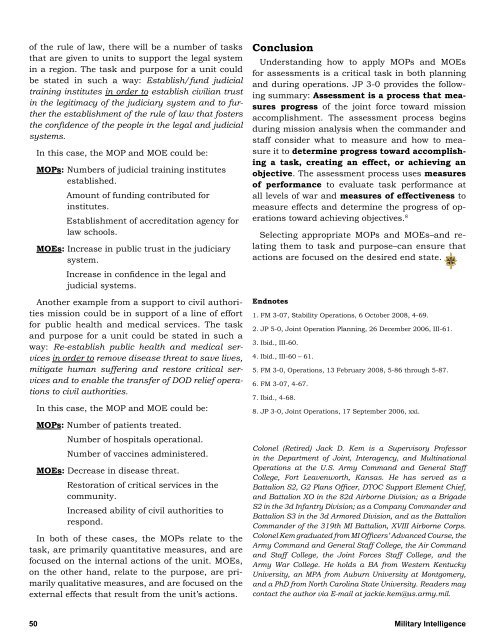Military Intelligence Professional Bulletin - Federation of American ...
Military Intelligence Professional Bulletin - Federation of American ...
Military Intelligence Professional Bulletin - Federation of American ...
Create successful ePaper yourself
Turn your PDF publications into a flip-book with our unique Google optimized e-Paper software.
<strong>of</strong> the rule <strong>of</strong> law, there will be a number <strong>of</strong> tasks<br />
that are given to units to support the legal system<br />
in a region. The task and purpose for a unit could<br />
be stated in such a way: Establish/fund judicial<br />
training institutes in order to establish civilian trust<br />
in the legitimacy <strong>of</strong> the judiciary system and to further<br />
the establishment <strong>of</strong> the rule <strong>of</strong> law that fosters<br />
the confidence <strong>of</strong> the people in the legal and judicial<br />
systems.<br />
In this case, the MOP and MOE could be:<br />
MOPs: Numbers <strong>of</strong> judicial training institutes<br />
established.<br />
Amount <strong>of</strong> funding contributed for<br />
institutes.<br />
Establishment <strong>of</strong> accreditation agency for<br />
law schools.<br />
MOEs: Increase in public trust in the judiciary<br />
system.<br />
Increase in confidence in the legal and<br />
judicial systems.<br />
Another example from a support to civil authorities<br />
mission could be in support <strong>of</strong> a line <strong>of</strong> effort<br />
for public health and medical services. The task<br />
and purpose for a unit could be stated in such a<br />
way: Re-establish public health and medical services<br />
in order to remove disease threat to save lives,<br />
mitigate human suffering and restore critical services<br />
and to enable the transfer <strong>of</strong> DOD relief operations<br />
to civil authorities.<br />
In this case, the MOP and MOE could be:<br />
MOPs: Number <strong>of</strong> patients treated.<br />
Number <strong>of</strong> hospitals operational.<br />
Number <strong>of</strong> vaccines administered.<br />
MOEs: Decrease in disease threat.<br />
Restoration <strong>of</strong> critical services in the<br />
community.<br />
Increased ability <strong>of</strong> civil authorities to<br />
respond.<br />
In both <strong>of</strong> these cases, the MOPs relate to the<br />
task, are primarily quantitative measures, and are<br />
focused on the internal actions <strong>of</strong> the unit. MOEs,<br />
on the other hand, relate to the purpose, are primarily<br />
qualitative measures, and are focused on the<br />
external effects that result from the unit’s actions.<br />
Conclusion<br />
Understanding how to apply MOPs and MOEs<br />
for assessments is a critical task in both planning<br />
and during operations. JP 3-0 provides the following<br />
summary: Assessment is a process that measures<br />
progress <strong>of</strong> the joint force toward mission<br />
accomplishment. The assessment process begins<br />
during mission analysis when the commander and<br />
staff consider what to measure and how to measure<br />
it to determine progress toward accomplishing<br />
a task, creating an effect, or achieving an<br />
objective. The assessment process uses measures<br />
<strong>of</strong> performance to evaluate task performance at<br />
all levels <strong>of</strong> war and measures <strong>of</strong> effectiveness to<br />
measure effects and determine the progress <strong>of</strong> operations<br />
toward achieving objectives. 8<br />
Selecting appropriate MOPs and MOEs–and relating<br />
them to task and purpose–can ensure that<br />
actions are focused on the desired end state.<br />
Endnotes<br />
1. FM 3-07, Stability Operations, 6 October 2008, 4-69.<br />
2. JP 5-0, Joint Operation Planning, 26 December 2006, III-61.<br />
3. Ibid., III-60.<br />
4. Ibid., III-60 – 61.<br />
5. FM 3-0, Operations, 13 February 2008, 5-86 through 5-87.<br />
6. FM 3-07, 4-67.<br />
7. Ibid., 4-68.<br />
8. JP 3-0, Joint Operations, 17 September 2006, xxi.<br />
Colonel (Retired) Jack D. Kem is a Supervisory Pr<strong>of</strong>essor<br />
in the Department <strong>of</strong> Joint, Interagency, and Multinational<br />
Operations at the U.S. Army Command and General Staff<br />
College, Fort Leavenworth, Kansas. He has served as a<br />
Battalion S2, G2 Plans Officer, DTOC Support Element Chief,<br />
and Battalion XO in the 82d Airborne Division; as a Brigade<br />
S2 in the 3d Infantry Division; as a Company Commander and<br />
Battalion S3 in the 3d Armored Division, and as the Battalion<br />
Commander <strong>of</strong> the 319th MI Battalion, XVIII Airborne Corps.<br />
Colonel Kem graduated from MI Officers’ Advanced Course, the<br />
Army Command and General Staff College, the Air Command<br />
and Staff College, the Joint Forces Staff College, and the<br />
Army War College. He holds a BA from Western Kentucky<br />
University, an MPA from Auburn University at Montgomery,<br />
and a PhD from North Carolina State University. Readers may<br />
contact the author via E-mail at jackie.kem@us.army.mil.<br />
50 <strong>Military</strong> <strong>Intelligence</strong>
















